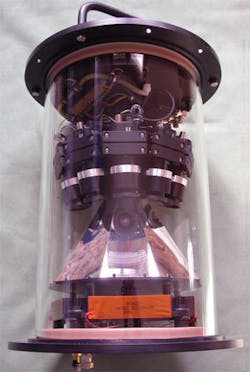Optical design gives panoramic views
Andrew Wilson, Editor, [email protected]
Many surveillance, security, robot-navigation, and endoscope systems require capture of 360° images of surrounding objects. To meet this demand, some companies now offer a variety of imaging systems that vary in both design concept and price/performance (see table on p. 14). These systems can use multiple cameras, rotating optical devices, panoramic lenses, and nonplanar and planar mirrors.
More often than not, low-cost approaches use a single stationary camera with either a fisheye or panoramic lens or with a normal lens looking off a nonplanar mirror. Because these approaches use a single image sensor, the resolution is inherently lower than multiple-camera designs. “In addition,” says Vic Nalwa, president of FullView (Holmdel, NJ, USA; www.fullview.com), “reflections off nonplanar mirrors generally result in blurred images due to optical aberrations introduced by the mirrors.” Some other designs use a single rotating camera to create a single wide-field-of-view image, but these designs are generally unsuitable for nonstationary scenes as moving objects appear distorted, fragmented, or even missing.
To overcome these limitations, multiple fixed cameras looking in different directions can be used. However, these too can have limitations. “Multiple cameras looking directly into the scene from different positions see the world with inherently different perspectives-that is, they each see each point in space in an inherently different depth-dependent direction,” says Nalwa. “This makes it impossible, in general, to combine images from multiple cameras looking directly out into a single coherent image without image blending, a process that not only requires substantial overlap between adjoining images, but is also computationally expensive and often leads to image artifacts and image blur.”
To obtain the highest image quality, multiple cameras looking off planar mirrors can be used. “Reflections off planar mirrors are clear and sharp, irrespective of the size of the camera aperture and its position relative to the mirror,” Nalwa explains. “Further, when planar mirrors are arranged such that multiple cameras look off them in different directions effectively from substantially the same viewpoint, the images from the different cameras are inherently identical where they adjoin, which allows them to be mosaiced into seamless larger images without any image blending.” Indeed, this is the approach taken by FullView in the development of a panoramic camera recently deployed onboard the USS George Washington, a Nimitz-class nuclear-powered aircraft carrier.
In the FullView design, ten RS-170 VGA cameras from Watec (Orangeburg, NY, USA; www.wateccameras.com) effectively stare in different directions from substantially the same viewpoint with each camera capturing images reflected off a different one of ten planar mirrors. “Although Watec cameras were used in the design for the US Navy,” says Nalwa, “different cameras can be used, depending on the resolution and sensitivity demanded by the customer.”
FullView teamed with MicroDISC (Yardley, PA, USA; www.microdisc.com) to develop a PC-based system. Captured images are warped in real time to create a partial image of the scene and then mosaiced into 360° images that are displayed in a panoramic fashion by streaming the data using the PC display controller.
In each FullView system, three Diligent PCI-X compatible frame grabbers from Euresys (Angleur, Belgium; www.euresys.com) digitize the ten RS-170 channels. “Because each board uses four separate video decoders and four separate MPEG-4 compression ICs,” says Nalwa, “each board can acquire images from up to four independent cameras and display full D1 (720 × 480) uncompressed video images from all at 30 frames/s and simultaneously transfer the four corresponding full D1 MPEG-4 streams to a 15,000-rpm Seagate drive in the host computer.” These images can be time stamped and used for archival and data retrieval.
The resulting camera system features a 360° horizontal and a +15° to -45° vertical field of view that produces 4000 × 600 × 8-bit gray-scale images. With a sensitivity of 5 × 10-5 lux at f/0.8, the camera system can monitor deck activity on the aircraft carrier at both day and night. “This application,” says Nalwa, “also dictated that the camera system be supplied in a nitrogen-pressurized, EMI-shielded, antireflective and shock-absorbent housing that is heated internally to allow camera operation at temperatures well below freezing.”



